- Creditors have suffered significant losses on a $233M CMBS loan backed by the former Sprint headquarters in Overland Park, Kansas, with $65M in the riskiest tranche completely wiped out.
- The deal highlights mounting challenges for older office assets in CMBS structures, even as demand for single-asset, single-borrower (SASB) deals for premium properties grows.
- Newer Class-A office properties are dominating SASB issuance, while legacy assets face plunging valuations, soft leasing demand, and rising delinquency rates.
A Costly Setback
Creditors of a commercial mortgage-backed security (CMBS) tied to the 207-acre Aspiria campus, formerly Sprint’s headquarters, are absorbing steep losses, reports Bisnow. The $233M office loan was recently sold, yielding just $164M. The shortfall wiped out the $65M junior CMBS tranche, hitting investors like Lord Abbett & Co.
Pandemic-Era Shifts Hit SASB Office Loans
SASB CMBS deals rose sharply, accounting for 45% of issuance last year, up from just 20% in 2023. However, most of these new deals are concentrated around Class-A office buildings in prime urban locations — not sprawling suburban campuses like Aspiria.
Recent headline SASB transactions include:
- $3.5B loan for New York’s Rockefeller Center (Oct 2024)
- $1.2B loan for the Seagram Building (Feb 2025)
- $1.1B loan for 3 Bryant Park
In contrast, older properties are facing dwindling leasing interest. Aspiria, a 20-building campus dating back to the 1990s, illustrates the uphill battle for suburban, Class-B and Class-C office assets.
Get Smarter about what matters in CRE
Stay ahead of trends in commercial real estate with CRE Daily – the free newsletter delivering everything you need to start your day in just 5-minutes
Declining Values And Rising Delinquencies
The office sector’s downturn has created a widening gap between asking and taking rents — 11.1% nationally for Class-B/C properties in Q1 2025, per CBRE. Meanwhile, Trepp reports a record 11% delinquency rate for office properties tied to CMBS, the highest on record.
Much of today’s office CMBS debt was issued during stronger market conditions with high demand, low vacancies, and long-term leases. Today, the picture is starkly different.
Looking Ahead
As investor appetite shifts toward trophy assets, aging office buildings with large footprints and outdated amenities are becoming increasingly difficult to refinance or reposition. The Aspiria loss could foreshadow more distress to come in the Class-B and Class-C office CMBS market.


















